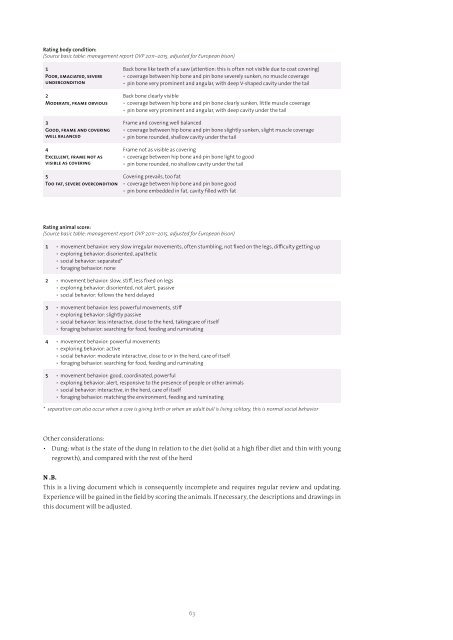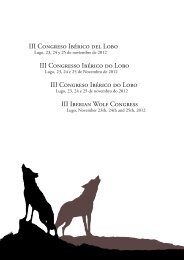Bison-Rewilding-Plan-2014
Bison-Rewilding-Plan-2014
Bison-Rewilding-Plan-2014
- No tags were found...
You also want an ePaper? Increase the reach of your titles
YUMPU automatically turns print PDFs into web optimized ePapers that Google loves.
Rating body condition:(Source basic table: management report OVP 2011–2015, adjusted for European bison)1Poor, emaciated, severeundercondition2Moderate, frame obvious3Good, frame and coveringwell balanced4Excellent, frame not asvisible as coveringBack bone like teeth of a saw (attention: this is often not visible due to coat covering)• coverage between hip bone and pin bone severely sunken, no muscle coverage• pin bone very prominent and angular, with deep V-shaped cavity under the tailBack bone clearly visible• coverage between hip bone and pin bone clearly sunken, little muscle coverage• pin bone very prominent and angular, with deep cavity under the tailFrame and covering well balanced• coverage between hip bone and pin bone slightly sunken, slight muscle coverage• pin bone rounded, shallow cavity under the tailFrame not as visible as covering• coverage between hip bone and pin bone light to good• pin bone rounded, no shallow cavity under the tail5Too fat, severe overconditionCovering prevails, too fat• coverage between hip bone and pin bone good• pin bone embedded in fat, cavity filled with fatRating animal score:(Source basic table: management report OVP 2011–2015, adjusted for European bison)1 • movement behavior: very slow irregular movements, often stumbling, not fixed on the legs, difficulty getting up• exploring behavior: disoriented, apathetic• social behavior: separated*• foraging behavior: none2 • movement behavior: slow, stiff, less fixed on legs• exploring behavior: disoriented, not alert, passive• social behavior: follows the herd delayed3 • movement behavior: less powerful movements, stiff• exploring behavior: slightly passive• social behavior: less interactive, close to the herd, takingcare of itself• foraging behavior: searching for food, feeding and ruminating4 • movement behavior: powerful movements• exploring behavior: active• social behavior: moderate interactive, close to or in the herd, care of itself• foraging behavior: searching for food, feeding and ruminating5 • movement behavior: good, coordinated, powerful• exploring behavior: alert, responsive to the presence of people or other animals• social behavior: interactive, in the herd, care of itself• foraging behavior: matching the environment, feeding and ruminating* separation can also occur when a cow is giving birth or when an adult bull is living solitary, this is normal social behaviorOther considerations:• Dung: what is the state of the dung in relation to the diet (solid at a high fiber diet and thin with youngregrowth), and compared with the rest of the herdN .B.This is a living document which is consequently incomplete and requires regular review and updating.Experience will be gained in the field by scoring the animals. If necessary, the descriptions and drawings inthis document will be adjusted.63



